This is the third story in a series on covering protests in Latin America. Read the first and second here*
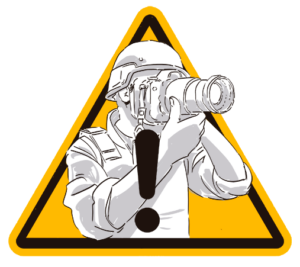
(Illustration: Pablo Pérez "Altais")
When the team from investigative media outlet Cuestión Pública in Colombia decided to send a correspondent to the city of Cali to cover the demonstrations that had begun on April 28, 2021 throughout the country, they knew they had to send him prepared "as if it were a war.”
"In general, there are very few guarantees for those who decide to go out with a camera, wear a press badge," Diana Salinas, director and co-founder of the media outlet, told LatAm Journalism Review (LJR) at the time. “If there is someone who wants to do it consistently, they have to know that they have to go with some important protection measures, but they also have to have medical insurance that will attend to them urgently, a transfer to the clinic, these are things that are going to happen, that you have to keep on your radar as if it were a war.”
Covering protests that have sometimes turned violent in recent years in Latin America is a challenge for journalists who may not receive special training or preparation. While it’s the job of the State to guarantee journalist safety, and experts say the role of media leadership is key to protecting their employees, journalists must also take measures to ensure they leave the streets unscathed, mentally and physically.
LJR spoke with press freedom advocates about the role of the State in guaranteeing safety, as well as journalist safety and protection experts about recommendations for before and after covering protests.
[See the first and second installments of this series on protecting journalists]
The State: The first guarantor of journalism and the protection of reporters
The safety of journalists, especially when it has to do with the actions of the security forces, is first of all, the responsibility of the State –which must create adequate conditions for journalists to cover events without any type of intimidation, either from security forces or other actors. Different organizations have spoken about this issue, but without a doubt, the most important jurisprudence for the region was established by the Inter-American Court of Human Rights (I/A Court) in the case of Vélez Restrepo v. Colombia.
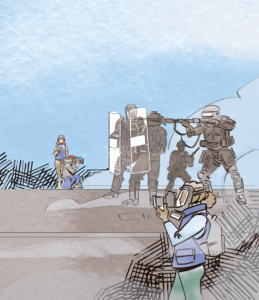
(Illustration: Pablo Pérez "Altais")
The case has to do with the beating, threats and intimidation suffered by cameraman ‘Richard’ Vélez Restrepo when he was covering a demonstration that became violent due to intervention of members of the country's Army. He was later threatened not only for recording these events, but also for seeking justice.
“This is a very particular case in which the Inter-American Court had the opportunity to analyze certain guarantees for journalistic coverage when we are talking about events of high public interest such as a protest or a social grievance, but also the way in which the State addresses those grievances,” Pedro Vaca, Special Rapporteur for Freedom of Expression of the Inter-American Commission on Human Rights (IACHR), told LJR.
The ruling states that there must be guarantees so that the press can carry out its work covering these events of public interest, and those guarantees include prevention of violence against journalists during coverage as well as the investigation and punishment if violent events occur, Vaca explained.
"In several episodes of protest during this year we have registered attacks against journalists and these attacks are assigned to members of the security forces and the same also to protesters," Vaca said. “[This indicates that] the proposals of this judgment are of urgent implementation by the States because the fact that there is a significant portion of aggressions that come from the security forces or that are assigned to the security forces marks an important challenge because they also fulfill a duty of guarantor of the right to freedom of expression.”
Preparation, preparation and more preparation
Without exempting the State from its responsibilities, journalists and media can also take measures that allow them, to a certain extent, to prevent or be less affected by acts of violence during the coverage of protests. Some experts even consider that being better prepared in matters of physical security helps to have greater peace of mind psychologically.
“Preparing will allow them to react in a better way to risks, attacks or incidents,” Paula María Saucedo, Article 19 Protection and Defense Officer, told LJR. "The more preparation and the more you talk about what measures are going to be taken or acted upon in the event of an emergency, it seems to me that emotionally and psychologically people react better."
It’s something in which Alejandra González, consultant in attention to victims of serious human rights violations, agrees.
"I see worse impacts in those who are not prepared, in those who do not envision themselves in a particular context, in those who do not know what to expect as opposed to those who do have a notion, who position their work in a conflict scenario,” she told LJR.
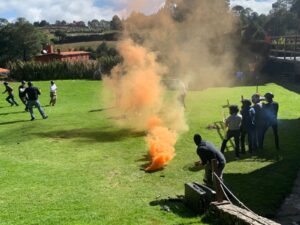
Hostile environment training (Courtesy: IWMF)
Despite the violence experienced by journalists during demonstrations, experts say awareness about these dangers is still lacking.
For González, for example, it is “impressive” how media can handle so much information, know so many contexts, but they do not carry out risk analysis in relation to their own work.
"You [cannot] be naive in the type of work that is going to be done," González explained. “We cannot be innocent in the type of work we do and how uncomfortable it is. I believe that there is self-responsibility without losing sight of the fact that the obligation and respect for our work is an issue that governments basically have to respect.”
Although Jeff Belzil, director of security for the International Foundation for Women in the Media (IWMF) who has worked with journalists and media in Latin America and the Caribbean, does believe that unfortunately only the "trauma" experienced while reporting leads journalists to change their mentality, he also believes that trainings in hostile environments have an important impact. And for that reason, it is so necessary that both media and journalists work to carry them out.
Especially before the pandemic, these trainings led by Belzil, which include environments like the one you would see in protests that turn violent, feature tear gas, pepper spray, actors, and more that create a very real atmosphere.
"I put them in a situation where they [tell me] 'hey, I wasn't prepared for that so I couldn't react, I couldn't do my job.' And from there they prepare a little better for real life because they saw that they weren't ready," Belzil told LJR.
Both Belzil and Judith Matloff, an expert on security and safety, believe that the first step in preparation is to know the context of the country and the protests where journalists will be reporting.
“Every country and the regions and municipalities within it differ,” Matloff told LJR. “What goes down in DF [Federal District of Mexico City] does not necessarily apply to a Rio favela or Matamoros [Mexico] or Medellín [Colombia]. So, journalists have to know how security forces and bad guys respond in that particular locale.”
In the same way that a journalist would prepare to cover a story, they should know the tactics used by each of these parties.
“These tactics are constantly evolving so journalists have to remain current and evaluate responses on a weekly, or daily, basis,” Matloff added.
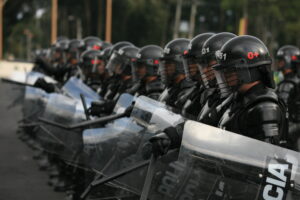
ESMAD, the Mobile Anti-Riot Squad of the National Police of Colombia (National Police of Colombia, CC BY-SA 2.0, via Wikimedia Commons)
In the case of Colombia, for example, Belzil points out that Esmad (Mobile Anti-Riot Squad) – a dependency of the National Police – is one of the most highly trained security forces in the region.
“It is like the Israel of Latin America in terms of their tactics, of the violence they use. So [the journalists] have to arrive very, very prepared because this Mobile Anti-Riot Squad is very, very, very trained, it has new equipment, it has new anti-riot weapons, it has new grenades, it has many things that are not available in other countries,” he said.
Matloff notes that colleagues, organizations such as CPJ or human rights groups should be asked to see patterns and how they can prepare.
In Latin America, journalists can come across weapons used by both security forces and protesters, including tear gas, pepper spray, rubber bullets, truncheons, horses, Molotov cocktails, rocks, bricks and even live ammunition.
Brazilian journalist Clarinha Glock is an author on the protest security guide from the Brazilian Association of Investigative Journalism (Abraji), created the year after protests in the country in 2013. She also collaborated in the Risk Map for Journalists for the Inter-American Press Association (IAPA).
In both guides, and in several safety courses for journalists that she has taught throughout her career, she emphasizes that the guidelines are “suggestive” or “only valid in some specific situations.”
“When you go to war, you know you have to be careful, be prepared, know which documents to use. In a way, what's happening is you need security preparation for the day to day as well,” Glock told LJR. “If showing a badge and identifying as the press were safe-conduct for coverage before, we began to see that the press was being attacked by the security forces because of the allegations [of abuse] and, also, by the protesters.”
Prevention also includes other decisions such as what type of clothing to wear, who will be monitoring the journalist's trail, what is the refuge or escape plan, among others. [View the box at the end of this article for more detailed information]
Don’t forget preparation and psychological monitoring
A traumatic event can lead to problems for a reporter, ranging from headaches, sweating, forgetfulness, palpitations to post-traumatic stress disorder with symptoms associated with depression that include lack of appetite, changes in sleep, disturbances to functioning, among others, as González said.
This leads to their work being affected, the expert added. Journalists may produce less or poor quality work, or procrastinate in delivering work. Their family life – relationships with children, partner and other relatives – and even in their sexual life, especially if the assault has had a sexual connotation, can be affected.
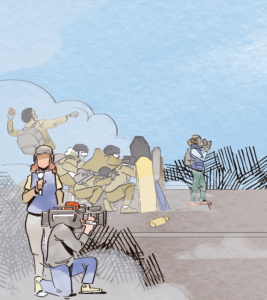
(Illustration: Pablo Pérez "Altais")
"And then there is the other case where we see the most serious impacts reflected and that is when there is a rupture in their life plan," González explained. “The more traumatic an event is, the more disconcerting, the less access you have to a complaint or to justice, etc., the greater rupture in the life plan and that is where the damage will be even more chronic.”
So, preparation should also include a psychological component, as stated by Elana Newman, a doctor of psychology specializing in journalism and trauma and research director of the DART Center.
“We have to start thinking about a before, during and after plan, just like you would for your press coverage,” she told LJR.
This involves thinking about where each person is psychologically vulnerable, what they can do to stay calm during the event, and what steps to take afterward to take care of yourself.
In general, the psychologist said, journalists are quite resilient. However, there are real workplace risks and hazards that professionals should be aware of.
To stay resilient, she recommends making sure journalists have social support, networks, and remember their mission, why they’re doing the job.
Here, experts say media also have great responsibility. On the one hand, they must make sure that their reporters know the limits, but above all, that they have support if they decide to abandon a reporting assignment for their own safety. In the face of an incident, they must follow up with the journalist.
“I would like editors to talk about safety with journalists. I would like them to talk about the limits, if things get ugly that you have no problem leaving the place,” Belzil said. “I would like to see that more: the media talking about the risks associated with the story and having a talk to say 'hey, I don't want you to put yourself in danger or get hurt' or 'nothing will happen if you leave or ask for help.”
For Belzil, these types of conversations are especially important for women journalists who, due to “the issue of machismo” that affects them in different settings, face a greater risk.
For Saucedo, from Article 19, and González, raising awareness with managers and media editors is important to ensure follow-up with journalists who face traumatic events. One of the things that helps is socializing, but also giving them their space. Not all people want to speak immediately.
González also emphasizes that a journalist must stay safe in order to fulfill his role, which is ultimately to inform.
“I don't know what the most expert journalists think, but from the psychosocial point of view, the ideal thing [in a dangerous situation] is to withdraw, where you do not have harm […] and to know how much we say in Mexico 'qué tanto callo?', that is, how much experience do you have in these kinds of moments and situations. But if there is no experience at all, the best thing is to withdraw,” González said. "Because I insist, the role or the work of reporters, journalists and others is to give an account, to let us know, and at the moment they are at risk, then we stop knowing. And that's a rule, right?”
EXPERT RECOMMENDATIONS
LJR presents a basic list of recommendations for journalists covering protests based on interviews with Jeff Belzil, Judith Matlof and Clarinha Glock.
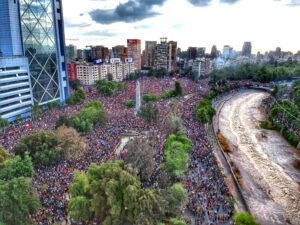
Protestors in Plaza Baquedano in Santiago, Chile in 2019 (Hugo Morales, CC BY-SA 4.0, via Wikimedia Commons)
Know the context of the place and the reasons why the demonstrations are taking place. At this point, you should know about the security forces of the country and city. What kinds of weapons have they used in the past?
For media (with journalists or freelancers)
ADDITIONAL RESOURCES FOR COVERING PROTESTS:
Teresa Mioli and Júlio Lubianco collaborated with this report.
*This is the third report in a series on journalist safety in Latin America and the Caribbean. This LatAm Journalism Review project is funded by UNESCO's Global Media Defense Fund.
Read the rest of the articles in this project at this link.
